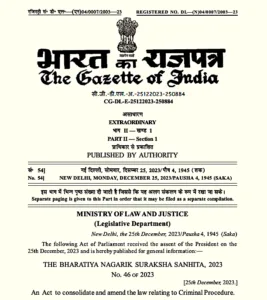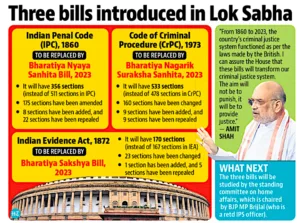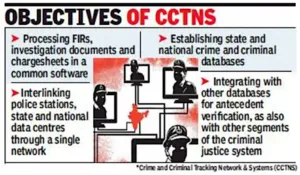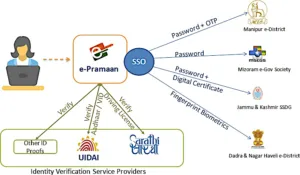Revised Criminal Law Bills: The Indian government has proposed significant reforms to modernize the outdated criminal justice system, addressing inefficiencies and delays. These changes aim to enhance fairness, transparency, and effectiveness.
Why are Criminal Law Bills in the News?
- The three new criminal laws were passed by Parliament in 2023 and come into effect from July 1, 2024, according to a notification by the Ministry of Home Affairs (MHA). Section 106(2) of the Bharatiya Nyaya Sanhita (BNS), which provides for punishment of “0-10 years” in “hit and run” cases, has been put on hold. Earlier this year, transporters and drivers across the country struck work to protest the particular provision.
- The Bharatiya Nyaya Sanhita, Bharatiya Nagrik Suraksha Sanhita and the Bharatiya Sakshya Adhiniyam will replace the Indian Penal Code, 1860; Code of Criminal Procedure, 1898; and the Indian Evidence Act, 1872, respectively, received President Droupadi Murmu’s assent on December 25, 2023.


A Brief History of Criminal Laws in India
- The evolution of criminal laws in India spans centuries, showcasing the dynamic changes in governance, society, and legal philosophy. This development can be categorized through various historical periods:
Ancient India:
- Dharma Shastras: These ancient legal texts, including the Manusmriti, established principles of justice and morality. They outlined punishments for crimes and addressed social and moral behaviour.
- Arthashastra: Attributed to Chanakya, this text detailed law enforcement, punishment, and the administration of justice during the Maurya period.
Medieval Period:
- Islamic Influence: With the advent of Islamic rule, the Sharia legal system began to shape criminal laws in areas under Muslim governance. Qazis adjudicated criminal cases using Islamic jurisprudence.
- Hindu-Muslim Legal Synthesis: In regions where Hindu and Muslim communities coexisted, a blend of Hindu and Islamic legal principles emerged.
Colonial Era:
- Regulating Act of 1773: The British East India Company introduced English law and established a legal system through the Regulating Act, creating courts to administer justice.
- Indian Penal Code (IPC), 1860: Drafted by Thomas Babington Macaulay, the IPC was enacted and came into effect on January 1, 1862. It remains a foundational criminal statute in India, detailing offences and their punishments.
- Code of Criminal Procedure (CrPC), 1898: The CrPC laid out procedures for the administration of criminal justice, including the powers of the police, conduct of trials, and the role of the judiciary.
Post-Independence Period:
- Constitution of India, 1950: The Constitution guarantees fundamental rights and principles of criminal justice, emphasizing fair trials and protection against arbitrary arrest and detention.
- Amendments and New Legislation: The IPC and CrPC have been amended to meet evolving societal needs. New laws, such as the Narcotic Drugs and Psychotropic Substances Act (1985) and the Prevention of Corruption Act (1988), have been enacted to address new challenges. Additionally, courts have decriminalized certain offences, including consensual intercourse between same-sex adults, adultery, and attempts to commit suicide.
What is the Criminal Justice System of India?
About the system:
- The criminal justice system includes laws, procedures, and institutions aimed at preventing, detecting, prosecuting, and punishing crimes while protecting individual rights and safety.
- In India, the existing system, which operates under the Indian Penal Code (IPC) and Criminal Procedure Code (CrPC), is about to be overhauled with the introduction of the Bharatiya Nyaya Sanhita and Bharatiya Nagarik Suraksha Sanhita to replace the current codes.
Main Pillars:
- Police: Tasked with investigating crimes, apprehending suspects, and enforcing the law under state jurisdiction.
- Judiciary: Interprets and applies the law, rendering judgments in criminal cases. The Supreme Court at the federal level and High Courts at the state level oversee lower courts.
- Correction System: Operates prisons and jails, emphasizing punishment and ideally rehabilitating offenders.
Key Principles:
- Presumption of Innocence: Individuals accused of crimes are considered innocent until proven guilty beyond a reasonable doubt.
- Right to a Fair Trial: Accused individuals are entitled to a fair and public trial, with the opportunity to present a defense and evidence.
- Due Process: Legal procedures must be properly followed to ensure the fairness of trials.
Recent Reforms:
- Criminal Law (Amendment) Act, 2013: Enacted in response to the Nirbhaya case, this amendment strengthened laws related to sexual offences, introducing new offences and enhancing penalties.
- Juvenile Justice (Care and Protection of Children) Act, 2015: This law addresses offences committed by juveniles and aims to rehabilitate and protect children in conflict with the law.
- The Criminal Law (Amendment) Act, 2018: This amendment introduced changes to the IPC and CrPC, including stricter provisions for crimes against women and children.
Why is there a need for change?
- Outdated Criminal Laws: The current criminal laws are antiquated, resulting in government agencies harassing innocent civilians and placing excessive pressure on the judiciary to resolve cases with limited and redundant laws.
- Judiciary Inefficiency: The judicial system is slow, often taking years to deliver justice, which fails to deter criminals effectively. There is a lack of cooperation between the judiciary, prosecutors, and the police, allowing many guilty individuals to go free while the innocent remain under trial. NCRB data shows that approximately 67.2% of the prison population consists of under-trial prisoners.
- Complexity of Crime: Crime rates have surged, and the nature of crimes has become more complex due to technological advancements. India’s criminal justice system is not equipped to handle the novel crimes of the modern era.
- Inefficient Investigations: Investigative procedures are often disorganized and inefficient, leading to delayed justice.
- Inequality in Justice: The wealthy and powerful rarely face conviction, even for serious crimes. The increasing nexus between politics and crime makes it challenging for the poor and marginalized to obtain justice.
- Lack of Public Confidence: Civilians have lost faith in the criminal justice system, viewing it as expensive, complicated, inefficient, and protracted. This distrust has contributed to social issues such as mob lynching.
What are the Proposed Changes in India’s Criminal Justice System?
- New Criminal Laws will come into force on July 1, 2024.
- The significance of the three new criminal laws is multifaceted and aims to modernize and streamline the criminal justice system in India.
- Bharatiya Nagrik Suraksha Sanhita (BNSS)
- Bharatiya Nyaya Sanhita (BNS)
- Bharatiya Sakshya (BS)
Proposed Changes in the Bharatiya Nyay Sanhita Bill, 2023:
- Definition of Terrorism: Unifies definitions of terrorism and related offences under a single framework.
- Repeal of Sedition: Removes sedition as an offence, addressing criticisms that it suppresses free speech and dissent.
- Capital Punishment for Mob Lynching: Establishes the death penalty as the maximum punishment for mob lynching, tackling a significant societal issue.
- Imprisonment for Sexual Deception: Introduces a 10-year imprisonment for deceiving women with false marriage promises, aiming to prevent exploitation.
- Introduction of Community Service: Implements community service as a punishment for specific crimes, focusing on rehabilitation and reducing prison overcrowding.
- Timely Filing of Charge Sheets: Requires that charge sheets be filed within a maximum of 180 days to expedite trials and avoid prolonged delays.
Proposed Amendments in the Bhartiya Nagrik Suraksha Sanhita Bill, 2023:
- The bill promotes the use of technology for trials, appeals, and recording depositions, including video-conferencing for legal proceedings.
- It mandates the mandatory video-recording of statements from survivors of sexual violence to protect evidence and prevent coercion or manipulation.
- The bill stipulates that police must update complainants on the status of their complaints within 90 days, enhancing accountability and transparency.
- Section 41A of the CrPC will be renumbered as Section 35, now requiring approval from at least a Deputy Superintendent of Police (DSP) before arresting individuals for offences punishable by less than 3 years or involving individuals above 60 years.
- The bill mandates police consultation with victims before withdrawing cases punishable by seven years or more, ensuring justice integrity.
- It allows trials in absentia for fugitive criminals, strengthening deterrence against absconders.
- The bill empowers magistrates to consider offences based on electronic records such as emails, SMSs, and WhatsApp messages, facilitating evidence collection and verification.
- Mercy petitions in death sentence cases must be filed within 30 days to the Governor and within 60 days to the President, with no right of appeal against the President’s decision in any court.
- Proposed Changes in the Bharatiya Sakshya Bill, 2023:
- The bill defines electronic evidence as any data generated or transmitted by any device or system capable of storage or retrieval through any means.
- It sets out specific criteria for admitting electronic evidence, emphasizing authenticity, integrity, and reliability to prevent misuse or alteration of digital data.
- The bill includes provisions for the admissibility of DNA evidence, focusing on consent and maintaining the chain of custody to enhance the accuracy and reliability of biological evidence.
- It recognizes expert opinions, such as medical assessments and handwriting analysis, as valid forms of evidence to establish pertinent facts or circumstances in a case.
- Additionally, the bill introduces the presumption of innocence as a fundamental principle of the criminal justice system, ensuring that every accused person is presumed innocent until proven guilty beyond a reasonable doubt.
Advantages and disadvantages of the three new criminal laws:
Advantages:
- Expanded Definition of Rape: The legislation now considers sexual intercourse with a minor wife as rape, providing broader protection for vulnerable individuals.
- Mob-Lynching Offenses: It acknowledges and criminalizes mob-lynching, which aims to address hate crimes more effectively.
- Repeal of Section 377: The law excludes Section 377 of the IPC, which criminalized consensual “carnal intercourse against the order of nature,” marking a progressive step.
- Enhanced Judicial Processes: Measures like video-conferencing for trials and timelines for speedy trials are introduced to improve justice delivery, contingent on effective implementation.
Disadvantages:
- Consultation and Passage Issues: The hurried parliamentary passage during the pandemic raised procedural and consultative concerns among legal experts and stakeholders.
- Limited Overhaul: While significant, some experts argue that the new laws do not constitute a complete overhaul of existing legislation.
- New Sedition Provisions: Despite claims to the contrary, the laws introduce broader definitions of sedition, potentially impacting free speech.
- Gender-Neutral Rape Laws: The absence of gender-neutral rape laws limits legal recourse for male victims of sexual assault, highlighting an ongoing issue.
Issues in the current criminal justice system of India include:
- Case Backlog: More than 4.7 crore cases are pending in Indian courts, leading to significant delays in delivering justice and eroding public trust.
- Inadequate Resources and Infrastructure: The system suffers from insufficient funding, manpower shortages, and inadequate facilities. There are only 21 judges per million people, and high courts and lower judiciary positions often remain unfilled.
- Quality of Investigation and Prosecution: Law enforcement agencies frequently encounter interference, corruption, and a lack of accountability, which compromise the fairness and professionalism of investigations.
- Human Rights Concerns: Issues such as custodial torture, extrajudicial killings, coerced confessions, and unfair trials raise serious human rights concerns within the system.
- Outdated Laws and Procedures: Many laws date back to 1860 and fail to address modern crimes like cybercrime and terrorism effectively, necessitating reforms to align with contemporary challenges.
- Public Perception: The police are often perceived as corrupt, inefficient, and unresponsive, negatively impacting their relationship with the public and overall law enforcement effectiveness.
Some reform initiatives by various committees on India’s criminal justice system:
- Vohra Committee, 1993:
- Focused on addressing the criminalization of politics and the nexus among politicians, bureaucrats, criminals, and anti-social elements. It recommended establishing an institution for intelligence gathering and taking action against such elements.
- Malimath Committee, 2003:
- Suggested a comprehensive overhaul of the criminal justice system. Key proposals included introducing ‘social welfare offences,’ adopting a mixed system combining adversarial and inquisitorial elements, lowering the standard of proof, and allowing senior police officers’ confessions as evidence.
- Madhav Menon Committee, 2007:
- Drafted a national policy on criminal justice emphasizing human dignity, restorative justice, and improving coordination among police, judiciary, and prosecution.
- Supreme Court Directives on Police Reforms, 2006:
- Issued to ensure police autonomy, accountability, and professionalism. Directives included establishing State Security Commissions, fixed tenure for DGP selection, separation of police functions, and setting up Police Complaints Authorities.
How is the Government preparing to implement the 3 Criminal Laws?
- Training Implementation: The Bar Council of India has mandated the integration of these laws into university and legal education curricula starting from the academic year 2024-25.
- Publicity and Awareness: The Bureau of Police Research and Development (BPR&D) is leading an Inter-Ministerial Group to conduct a comprehensive publicity campaign.
- Technology Upgrades:
- The National Crime Records Bureau (NCRB) has implemented 23 functional upgrades in the Crime and Criminal Tracking Network and Systems (CCTNS) application, enhancing tech compatibility, including FIR registration.
- The National Informatics Centre (NIC) has developed applications such as eSakshya, Nyay Shruti, and eSummon to facilitate electronic documentation of crime scenes, judicial hearings, and court summons.
- Capacity Building: BPR&D has developed 13 training modules aimed at enhancing the capabilities of police, prison staff, prosecutors, judicial officers, forensic experts, and central police organizations.
Disclaimer: The article may contain information pertaining to prior academic years; for further information, visit the exam’s “official or concerned website“.
Explore our courses: https://apnipathshala.com/courses/
Explore Our test Series: https://tests.apnipathshala.com/
Download RNA PDF: https://apnipathshala.com/rna-real-news-and-analysis-08-july-2024/













